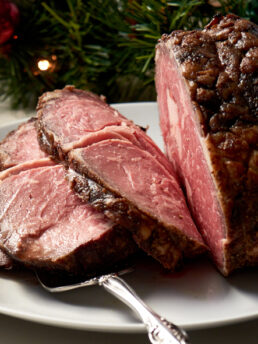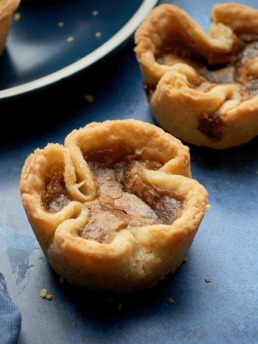Pierogi: Polish Dumplings
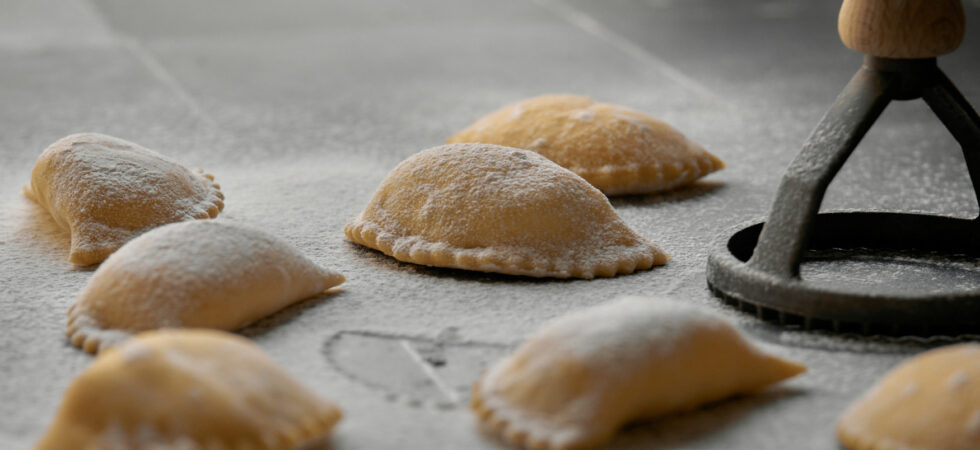
Pierogi (polish dumplings) are the first things I remember making as a kid. Every Christmas Eve, my whole family packs into the garage at a long table and toils away for half a day on these delicious little parcels. Seriously we make between 500-600 in a sitting. And, as the designated “quality control” person for 10 years running, I feel like I’m qualified to share my family recipe. So, here it is.
Below, you’ll get not only the dough recipe but three different filling recipes: farmer’s cheese and potato; sauerkraut; and American cheese and potato.
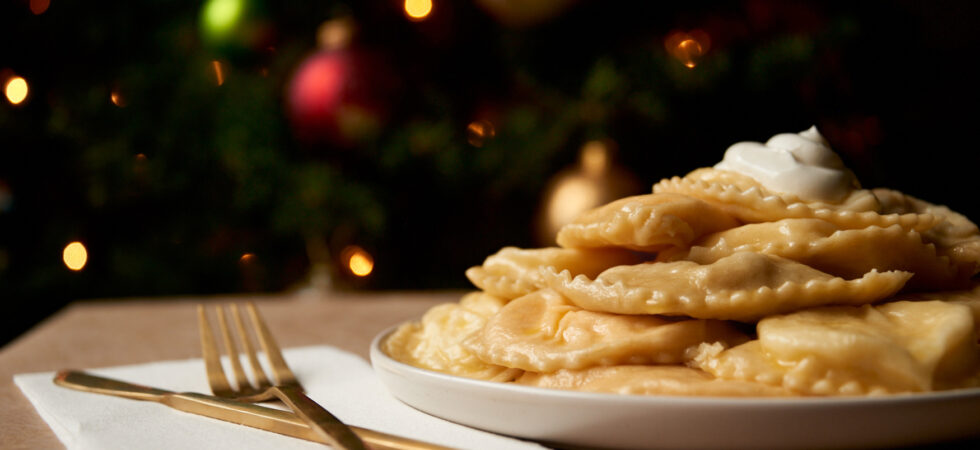
Get the Recipe: Pierogi
Ingredients
American Cheese & Potato Filling
- 1½ lbs russet potatoes, 2-4 potatoes depending on their size
- 10, American cheese slices
- 8 oz Velveeta cheese in 1/4in (.5cm) slices
Farmer’s Cheese & Potato Filling
- 1½ lbs russet potatoes, 2-4 potatoes depending on their size
- 2, 7.5 oz Friendship Dairies farmer's cheese packages
- ⅓ cup créme fraîche
- kosher salt to taste
Sauerkraut Filling
- 3, 32 oz jars of Silver Floss Bavarian Style Sauerkraut
Pierogi Dough
- 2 eggs
- 1 tsp kosher salt
- 4 cups King Arthur 00 flour
- 1 cup water
Equipment
- 1 peeler (both potato and cheese fillings)
- 1 beater attachment for a stand mixer (both potato and cheese fillings)
- 1 potato ricer (only farmer's cheese and potato filling)
- 1 Fine Mesh Strainer (sauerkraut)
- 1 large sauté pan or skillet (sauerkraut)
- 1 wooden spatula (sauerkraut)
- 1 stand mixer with whisk and dough hook attachment
- 1 Rolling Pin
- 1 3.5in (9cm) round cookie/biscuit cutter
- 1 thin sheet or tablecloth (optional)
- 1 #50, small cookie scoop
- 1 3in (7.6cm) round ravioli stamp (or a cup with the same circumference)
- 1 large pot
- 1 slotted spoon or spider strainer
- 2 baking trays or chafing dishes
- 1 kitchen towel, dampened
Instructions
Farmer’s Cheese & Potato Filling
- Place a medium pot of water with a generous helping of kosher salt, on your stove top. Peel the potatoes and add them whole to the cold water. If there are any potatoes that are a significantly larger size, cut those to match the others. You want the chunks to be as large as possible. Bring the water to a simmer, and boil the potatoes until they are fork tender. (A simmer means the surface of the water should move but not break. No bubbles)
- Once cooked, drain the potatoes and put them through a potato ricer into into the bowl of a stand mixer. Turn the mixer on low and add the farmer’s cheese and créme fraîche (pronounced krem FRESH). Mix until everything is well incorporated. The farmer’s cheese will always stay a bit crumbly. Add salt to taste, if needed. Place in a plastic container in the fridge to cool completely.
American Cheese & Potato Filling
- Place a medium pot of water with a generous helping of kosher salt, on your stove top. Peel the potatoes and add them whole to the cold water. If there are any potatoes that are a significantly larger size, cut those to match the others. You want the chunks to be as large as possible. Bring the water to a simmer, and boil the potatoes until they are fork tender. (A simmer means the surface of the water should move but not break. No bubbles)
- Once cooked, drain the potatoes and put them directly into the bowl of a stand mixer. Turn the mixer on low and add in a few slices of Velveeta and American cheese at a time. As each few pieces of cheese melt, add in more until all of the cheese is used. The potato mixture will become smooth and yellow. Scrape the mix into a plastic container and place it in the fridge to cool completely.
Sauerkraut Filling
- To start, drain the sauerkraut in a strainer, over a bowl. Set the easy to strain juice aside and then squeeze out any additional juice into the sink, to get it as dry as you can. Chop the sauerkraut strands down with a chef's knife or give them a few pulses in a food processor.
- On your stovetop, pre-heat a large skillet or sauté pan to a medium temperature and dump the sauerkraut directly into the pan, no oil or butter. Toast the sauerkraut with a wooden spatula until the pieces turn medium brown and don't readily stick to each other.
- If the sauerkraut sticks to the pan so much that you cannot scrape it off, use the strained juice to deglaze the bottom of the pan. Keep in mind, the point of frying is to toast and dry out the sauerkraut. Any, moisture added will need to be cooked off again.
- This should take roughly 25-30 minutes. When done, turn off the heat and let the toasted sauerkraut cool enough to stop steaming. Scrape it into a container and place it in the fridge to chill.
Pierogi
- When the fillings are completely chilled, it's time to set up your work spaces. It's best to have three separate areas: 1. the dough area; 2. the pierogi making area; and 3. the pierogi cooking area.
- For the dough area, clear a very large space to roll out the dough. Heavily dust it with flour and make sure to have your rolling pin, dough round cutter, and extra flour at-the-ready.
- For the pierogi shaping area, lay down a tablecloth or thin sheet of some kind, also dusted with flour, to keep the pierogi from sticking. Also put out the filling, a spoon, a ravioli press or cup, and extra flour.
- For the last space, you'll need a large pot filled ¾ of the way with water, a baking tray with softened butter (measured with your heart), a spider or slotted spoon, and a separate tray or serving dish to place the boiled and buttered pierogi.
- Now you are ready to make the dough. To do this, use a stand mixer, with whisk attachment, to whip the eggs until they start to foam and gain volume. Add the salt and continue whisking for about 10 seconds. Then, add flour and water to the mixer a little at a time. Use all of the water but not all of the flour. The dough should be the consistency of pancake batter. At this point, switch out the whisk for the dough hook and add in the rest of the flour. The dough is ready when the flour is fully incorporated and the dough pulls away from the sides of the bowl. If the dough is sticking at all to the bottom of the bowl when fully mixed and all the ingredients are in, add about ½tbsp (4g) of flour at a time until the dough is spinning freely of the bowl.
- As soon as this is achieved, stop the mixer and let the dough hydrate under a damp cloth for 20 minutes. When rested, scrape the dough out of the bowl onto your floured work surface. Cut a portion of the dough off and place the damp towel back over the remaining dough. Roll your portioned dough out as thin as you can get it (roughly 1/16in or .16cm). Add flour to your surface, as you roll, to stop the dough from sticking to your counter. When ready, cut 3.5in (9cm) circles out of the dough with a large biscuit or cookie cutter. Make each new circle as close as possible to the previous circle. Once all the circles have been cut into your rolled out dough, pull up the scraps and ball them up. You can throw this away or also put it under the damp towel to rehydrate and relax.
- Next, turn on the burner for the pot full of water, so it comes to a slow boil while you make the pierogi.
- Now, use a tablespoon or #50 cookie scoop to portion out some filling. There should be about 20-25g of potato filling by weight per scoop and/or 15g of sauerkraut per scoop. Make sure your hands are well floured. This helps you shape the filling into a semi-circle without it sticking to your fingers. Place your shaped filling onto a dough round. You want it to be in the center of the back-half of the circle, not the exact center. This way, it's easier fold the front-side of the dough over the filling without it stretching and breaking.
- As soon as you have the front of the circle folded over the filling, press down where the dough overlaps to create an initial seal and keep the filling from falling out. (This is more important with the sauerkraut filling, but it's still a good habit to have.) Next, use a round ravioli stamp or a plastic cup to cut off the excess edge of the pierogi and make a really good seal. (For a more traditional style, use your fingers to press the edges together) Make absolutely sure to inspect the edge for holes. If they aren't sealed, water can get in during the boiling process.
- When about 8-10 pierogi are made, place them into the pot to gently boil. After about 6-8 minutes, take out the pierogi and transfer them to the baking tray with several pats of butter. Shake the tray from side-to-side, ensuring that the pierogi are all very well coated in butter. Transfer the finished pierogi to a secondary dish or tray for storing or serving.
- You can then begin again wherever needed: boil the next 8-10 pierogi; shape new pierogi; or roll out more dough, etc. until all of the filling and dough is gone.
- Top with onion butter, salt, and/or sour cream to enjoy.
Notes
- Each type of filling needs one batch of dough. So, if you intend to make all three fillings you will need to triple the dough recipe or cut down the filling recipes.
- Fair warning, each filling recipe and the base dough recipe makes between 45-55 pierogi as written.
- Make the potato and cheese pierogi fillings the night before shaping the pierogi to allow the fillings to fully cool. Sauerkraut can be made a few hours in advance.
- You can reuse the dough scraps a second time, but know they will be a bit more tough, as you have developed more gluten by rolling it out. It will also be drier because if the additional flour from first use.
- If you are not serving the pierogi right away but want to keep them warm, cover them as tightly as possible with aluminum foil and place them in your oven on the lowest setting.
- To store or freeze pierogi, know you are combatting moisture and fragility of the dough in combination. The first way to fight this, is with the butter coating after boiling. This allows you to keep them in the fridge for 2-3 days without them sticking to each other. If you want to save them longer by freezing them, lay them flat, not touching, and in layers with wax paper between them. This way you can pull them out individually to reheat. Pierogi freeze well for about 2 months if sealed properly from freezer burn.
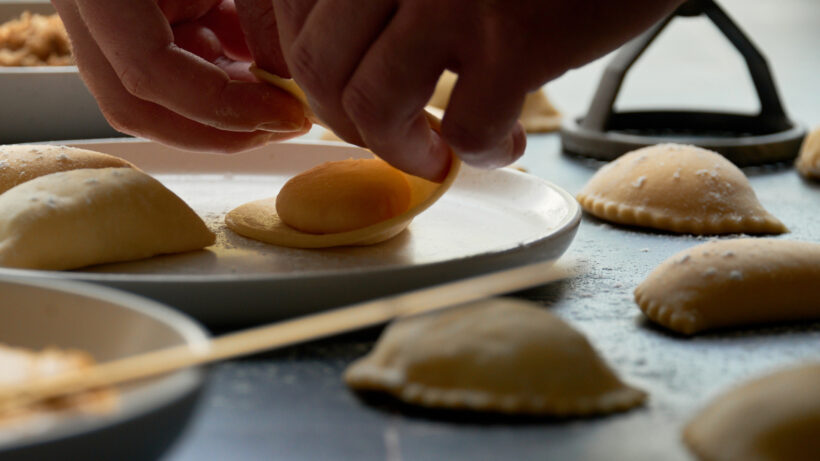
Frequently Asked Questions
Starting with cold water ensures that the potatoes are more evenly cooked. Slowly raising the temperature of the water gives the center of the potato time to increase in temperature with the rest of the potato before the water is hot enough to break down starch molecules.
If you add the potatoes to boiling water the outside will immediately begin to cook while the inside is still cold. In these cases, the outside starts to flake off and get waterlogged far in advance of the center being tender. This leads to watery and gummy potatoes.
The less surface area that touches the water, the less water logged the potato will get, and the drier the filling will be. A drier filling is important with dough that is very water soluble. If the dough gets too wet it gets sticky and/or disintegrates.
This also ensures there is more potato taste for the same reason. The less water absorbed by the potatoes the better.
The American and Velveeta cheeses are so melty that they thin out the potato mixture and ensure a creamy texture without the ricer.
Farmer’s cheese is crumbly, so I use the potato ricer and a bit of créme fraîche to give the mixture the creamier texture it’s lacking.
Tiny pieces of sauerkraut are easier to compact and envelope in the dough with success. We started to blitz or chop our sauerkraut strands so they wouldn’t get stuck in a seam or half-in and half-out of a pierog years ago. When that happens you either need to abandon the whole pierog and throw the dough away or pull out the strand and hope others aren’t attached to it. Then you need to try to seal the hole it made before boiling.
Remember, a hole in the pierogi, at best, means waterlogged filling and, at worst, means a pierogi fully opening. And, a pierogi open in a pot of water means lots of dissolved filling in the water. In these cases, you need to refill the pot and re-boil the water before you can start again. No thanks!
Sure! In my family, we sweetened regular sauerkraut with thinly sliced and chopped apples before we found the Bavarian style sauerkraut in stores. If you cannot find anything but regular sauerkraut, buy a few crisp apples as well as regular sauerkraut. Then add the chopped apple, a bit at a time, to the sauté pan with the sauerkraut, to sweeten it to your tastes.
If you cannot find farmer’s cheese, don’t worry, use whole milk ricotta. You can make a similarly textured filling by straining the liquid out of ricotta with a cheesecloth and dumping that into the potatoes. It will be a bit more creamy and mild than farmer’s cheese, but the créme fraîche can help add some tang back in. Feel free to add the créme fraîche to taste.
Like I said, measure with your heart. lol. Honestly, the more room temperature butter you use the less chance the pierogi have of sticking to each other at any given time. And, when you heat them up, a lot of the butter will melt off anyway. I would likely use 1-2 sticks (113.5-227g) of butter for this recipe.
Make the fillings up to 3 days in advance. I suggest, you check them everyday to see if there is any excess moisture on the inside of the containers. If so, gently wipe any water off the lids or filling surfaces with a paper towel.
The dough is best fresh. Make it the same day you intend to use it.
TLDR… Yes. But, you may need to add a bit more water to the dough.
Long answer… First, the 00 refers to how finely ground the flour is which ranges from 00 to 2. And, 00 flour is the finest level of ground flour. This means a lighter, softer dough.
But that’s not everything you need to know. For rolling purposes, King Arthur 00 flour’s protein content is 10.5% and all purpose flour protein is between 10 and 11.7%. This creates a nicely structured dough, with either type of flour, great for rolling out on a counter!
Finally, the main difference is textural. Because 00 flour uses soft wheat and AP flour uses hard wheat, 00 flour doughs are just that, soft.
Of note: As AP flour uses hard wheat and has a higher protein content, it will likely need more water than the recipe calls for. Add 1/2 tablespoon (7.5ml) of water at a time until it results in the described dough in the recipe.
This one is pretty straightforward. Yes, these flours would ensure a very soft-textured dough. However, they would have so little gluten that stretching the dough around the fillings would be very difficult. Can you use them? Yes! Would I recommend it to a beginner or even intermediate dumpling maker? NOPE!
I got you!
1. Increase the dough recipe by at least 50%: If you are just starting out on this or any similar dough-filled journey, make more dough so you can practice or throw out broken rounds without stressing about it.
2. Use a larger cookie/biscuit cutter: If you are new to making dumplings of any kind, do yourself a favor and make the dough rounds bigger. It gives you more forgiveness on filling placement and amount. And, even if you cut off more excess dough than I do, will anyone notice on the final product? Nope!
Thank you for asking. Yes, yes they can! Here’s the deal. The next day or even just after you make them, take a few pierogi and throw them into a pan on medium high heat. The butter you slathered them in will melt so you won’t need any extra oil or butter for the pan. While they start to cook, slice up some onion. Cook the first side of the pierogi until it is browned to your liking and then flip them over. At that same time, add in the onion and let them sauté down and char a bit. When everything is cooked, plate the pierogi and onions with a large dollop of sour cream on top and enjoy.
You can also sauté the onions separately if you want to do a big batch. I prefer this, because onions, and because onions and pierogi tend to cook at different rates, so your timing has to be pretty good if you cook them at the same time.


